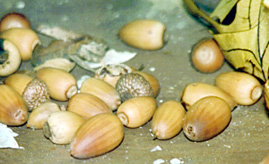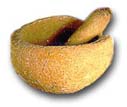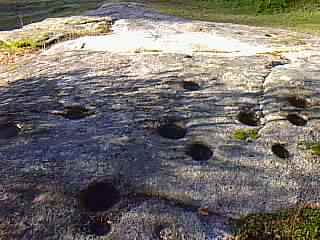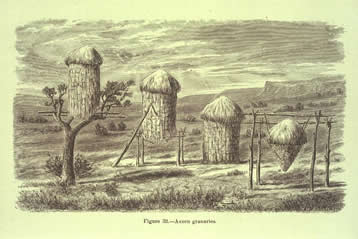Student Guide
1.READ

Read
the information about Gathering
------------------->
2.VIEW
![]()
Look
at all pictures on this page.
Be sure to click on any links or words that are underlined.
3.COLLECT
INFORMATION ![]()
Find
the answers to the following research questions.
Write your answers on Student
Worksheet 3
1. Whose job was it to gather food?
2. What foods did the tribelet gather?
3. When and where did the tribelet gather acorns?
4. Where were the acorns stored?
5. What foods were made from the acorns?
4.ACTIVITY

Extend
your thinking! Click on
the activity below:
Making
Acorn Mush


Gathering
The
women of the Bay Miwok tribe spent much of their time gathering,
preparing food, making baskets and mats, and taking care of the
children.
Basket making was an important part of a woman's life. It was a fine art that took a lot of patience and skill. It took months and even years to complete a basket, but taken care of, a basket could last a life time.
Bay Miwok women gathered most of the plant food for their families. They gathered food in baskets that the women carefully wove. They were careful to take only what they could use. Most of their food came from the nuts, roots, bulbs, berries, greens (leaves), and mushrooms gathered from the land.
Acorns were the tribes most important food. Entire villages would travel up into the hills of Mount Diablo in late September or early October to harvest acorns from the oak trees. The women and children collected the acorns in large "burden baskets" that they carried on their backs. After two or three weeks of gathering, a family would have as much as 1,000 - 2,000 pounds of acorns... enough to last them an entire year! After carrying the acorns home they would set them in the sun to dry. Once dried, the acorns were stored in a granary (chuck-ah) for the winter.
Acorns needed a lot of preparation before they could be eaten, they were
never eaten raw because they tasted too
bitter. Instead, they liked acorns ground up and baked into bread or cooked
into a hot cereal called mush.
Making acorn mush was hard work. The whole process took two to three hours.
Every time the women made acorn mush they had to repeat the same steps
over and over again.
Steps for Making Acorn Mush
1.
First, a woman would get some acorns from the granary. Then, she would
crack the acorn shell with a stone and remove  the
kernel from inside. After she had enough kernels, she put them in a rock
bowl called a mortar. She sat on the ground with her legs stretched out
in front of her. Then, she placed the bowl between her legs and began
hitting and grinding the acorn kernals with a stone hammer called a pestle.
Over and over she pounded the acorns until they were ground into flour.
the
kernel from inside. After she had enough kernels, she put them in a rock
bowl called a mortar. She sat on the ground with her legs stretched out
in front of her. Then, she placed the bowl between her legs and began
hitting and grinding the acorn kernals with a stone hammer called a pestle.
Over and over she pounded the acorns until they were ground into flour.
2. Next, the acorn flour was then put into a shallow basket and rinsed many times with water. She did this to wash away the bitter taste of the acorns. This could take an hour or more.
3.
Once the flour was made, it was mixed with water in a basked that was
woven so tight the water could not leak out.  Next,
she heated small stones in a fire. Once the stones became red-hot, she
lifted them from the fire with two sticks and dropped them in the basket
with the acorn flour and water. She used a stick to stir the mixture until
it started to boil and thicken. Finally, she removed the stones and the
acorn mush was ready to eat. If she wanted to make bread, she would form
a patty with the mush and bake it on a hot rock in the fire. The Bay Miwok
ate either acorn mush or acorn bread with every meal.
Next,
she heated small stones in a fire. Once the stones became red-hot, she
lifted them from the fire with two sticks and dropped them in the basket
with the acorn flour and water. She used a stick to stir the mixture until
it started to boil and thicken. Finally, she removed the stones and the
acorn mush was ready to eat. If she wanted to make bread, she would form
a patty with the mush and bake it on a hot rock in the fire. The Bay Miwok
ate either acorn mush or acorn bread with every meal.
LOOK AT THE PICTURES BELOW!!
 |
 |
 Stephen Powers, Univ. of California Press |
|
Women
and children collected acorns in large burden baskets that they
carried on their backs.
|
This
is bedrock mortar. Acorns were put in the holes and ground into
flour using a tool called a pestle.
|
Acorns
were stored above the ground in granaries. The granaries protected
the acorns from animals and flooding.
|
